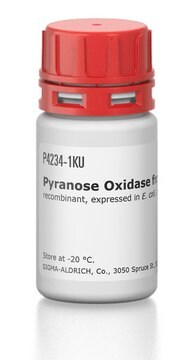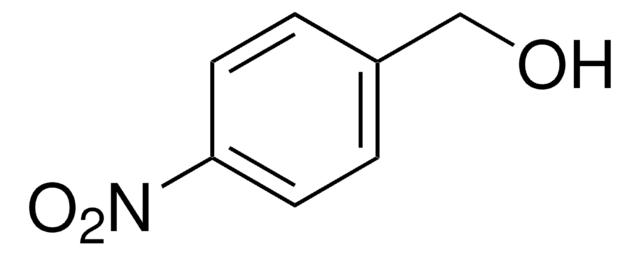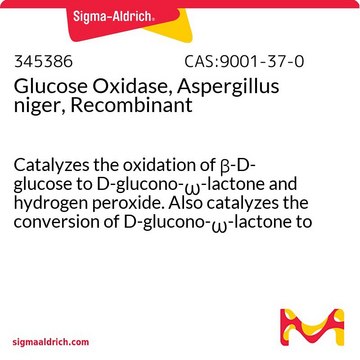P8279
Protocatechuate 3,4-Dioxygenase from Pseudomonas sp.
lyophilized powder, ≥3 units/mg solid
Se connecterpour consulter vos tarifs contractuels et ceux de votre entreprise/organisme
About This Item
Numéro CAS:
Numéro MDL:
Code UNSPSC :
12352204
Nomenclature NACRES :
NA.54
Produits recommandés
Source biologique
bacterial (Pseudomonas spp.)
Niveau de qualité
Forme
lyophilized powder
Activité spécifique
≥3 units/mg solid
Poids mol.
~700 kDa
Conditions d'expédition
dry ice
Température de stockage
−20°C
Description générale
Protocatechuate 3,4-Dioxygenase belongs to the non-heme iron family of enzymes. The active site of the enzyme contains Fe3+.
Application
Protocatechuate 3,4-Dioxygenase(PCD), from Pseudomonas sp., is used for the enzymatic determination of choline esterase when coupled with phydroxybenzoate hydroxylase. It is used to improve organic fluorophore-stability in single-molecule experiments and is used to study the metabolism of protocatechuate in Rhizobiaceae.
The enzyme has been used to create an oxygen scavenging system along with protocatechuate (PCA) and Trolox. The enzyme employs a nonheme iron center that catalyzes the conversion of PCA and molecular oxygen into β-carboxy-cis,cis-muconic acid, while the antioxidant Trolox suppresses slow blinking and photobleaching of cyanine dyes. It has been used in the preparation of imaging buffer along with DMB-BSA (dynein motility buffer-BSA), ATP and protocatechuate in single molecule motility assay.
Actions biochimiques/physiologiques
Protocatechuate 3,4-Dioxygenase catalyzes the degradation of 3,4-dihydroxybenzoate (protocatechuate) into β-carboxy-cis,cis-muconate.
Propriétés physiques
Structure : Protein with nonheme iron
Inhibitors : Ag+, Hg++, PCMB
Optimum pH : 9.0
Optimum temperature : 60−65°C
pH Stability : pH 7.0−9.0 (25°C, 72hr)
Thermal stability : below 50°C (pH 6.0, 1hr)
Inhibitors : Ag+, Hg++, PCMB
Optimum pH : 9.0
Optimum temperature : 60−65°C
pH Stability : pH 7.0−9.0 (25°C, 72hr)
Thermal stability : below 50°C (pH 6.0, 1hr)
Définition de l'unité
One unit will oxidize 1.0 μmole of protocatechuate to 3-carboxy-cis,cis-muconate per min at pH 7.5 at 37 °C.
Forme physique
Supplied as lyophilized powder.
Remarque sur l'analyse
Protein determined by biuret.
Inhibiteur
Réf. du produit
Description
Tarif
Code de la classe de stockage
11 - Combustible Solids
Classe de danger pour l'eau (WGK)
WGK 3
Point d'éclair (°F)
Not applicable
Point d'éclair (°C)
Not applicable
Équipement de protection individuelle
Eyeshields, Gloves, type N95 (US)
Faites votre choix parmi les versions les plus récentes :
Déjà en possession de ce produit ?
Retrouvez la documentation relative aux produits que vous avez récemment achetés dans la Bibliothèque de documents.
Les clients ont également consulté
Mindy I Davis et al.
Journal of the American Chemical Society, 124(4), 602-614 (2002-01-24)
The geometric and electronic structure of the high-spin ferric active site of protocatechuate 3,4-dioxygenase (3,4-PCD) has been examined by absorption (Abs), circular dichroism (CD), magnetic CD (MCD), and variable-temperature-variable-field (VTVH) MCD spectroscopies. Density functional (DFT) and INDO/S-CI molecular orbital calculations
A Buchan et al.
Applied and environmental microbiology, 67(12), 5801-5809 (2001-11-28)
Degradation of lignin-related aromatic compounds is an important ecological process in the highly productive salt marshes of the southeastern United States, yet little is known about the mediating organisms or their catabolic pathways. Here we report the diversity of a
Colin Echeverría Aitken et al.
Biophysical journal, 94(5), 1826-1835 (2007-10-09)
The application of single-molecule fluorescence techniques to complex biological systems places demands on the performance of single fluorophores. We present an enzymatic oxygen scavenging system for improved dye stability in single-molecule experiments. We compared the previously described protocatechuic acid/protocatechuate-3,4-dioxygenase system
Resonance Raman studies on protocatechuate 3, 4-dioxygenase inhibitor complexes
Que J L and Epstein R M
Biochemistry, 20(9), 2545-2549 (1981)
Brevibacterium fuscum protocatechuate 3, 4-dioxygenase. Purification, crystallization, and characterization.
Whittaker J W, et al.
The Journal of Biological Chemistry, 259(7), 4466-4475 (1984)
Notre équipe de scientifiques dispose d'une expérience dans tous les secteurs de la recherche, notamment en sciences de la vie, science des matériaux, synthèse chimique, chromatographie, analyse et dans de nombreux autres domaines..
Contacter notre Service technique











